Yellow Sand Wasp - Bembix palmata
Family Crabronidae
This page contains pictures and information about Yellow Sand Wasps that we found in the Brisbane area, Queensland, Australia.

- Body length 15mm
- Yellow Sand Wasps are medium to large in size with stout body and colours of yellow and black on thorax, black and white bands on abdomen. All legs are yellow with very minor black marks on joints. They are ground nesters. Females have fore basitarsi expanded and high number of rake spines for digging. They provision their nest with different insect prey, mainly flies.


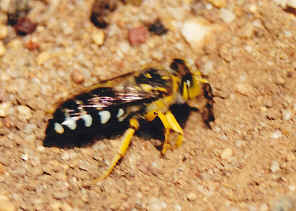
- We saw this Sand Wasp flying and hovering on a sandy foot path near a sub-urban street on Dec 2002. After landing on different positions, it chosen a place and started to dig into the ground. It spent about two minutes in digging a hole of about 10mm deep. Then it reached the hard part of the ground. It tried for one more minute then give up. It flied away and never returned.

- Female Yellow Sand Wasp constructs burrow under the ground, drags their paralyzed prey in and lay an egg in the burrow. Adult Digger Wasp feed on nectar.
Sand Wasp and Echo-location ??
- This wasp flies with the typical buzzing noise, especially when it flies very close to the ground. We noticed that the turbulence air under where the wasp was flying was exceptionally high. The dust and sand were blown around when the wasp was flying close to the ground, and it seems that the wasp was searching for something.



- We believed the wasp makes those turbulence to check if the soil is lose and easy to dig holes.



- The wasp may also use the buzzing noise as a sonic radar to detect the structure of the ground surface. It detects if any holes or hollow under the ground. If we can find and prove the wasp has some kinds of organ to receive the echo, then the sand wasp may be the 1st group of insects known that can handle the Echolocation technique (besides bats, humans, whales and dolphins, some birds etc.).
- We saw a number of them in Karawatha Forest during early summer on bare land with lose top soil surface.
Helper Sand Wasp Guarding the Nest



- The sand wasp nest in Karawatha Forest
- In Karawatha Forest during early summer next to the footpath, we saw two sand wasps flying over a patch of bare soil. On the top of those soil there were more than ten small holes, look like the entry of the sand wasp nest entrance. (Later we learn that those could be the decoy.) We noticed that one wasp guarding outside, the other wasp found the real entrance, dig into the soil. The wasp stayed underground for about two minutes, then came out and flied away. This wasp was look for food to feed the young in the nest so let call this wasp the provisioning wasp. The other let call it the guarding wasp.



- The guard wasp guiding the provisioning wasp digging into the entrance. The provisioning wasp


- The guarding wasp patrolled outside the nest while the provisioning wasp was underground and away for provision. The guarding wasp chased away any large insects flied near by two meters. There was a pattern of its patrolling flight. It rested for a few seconds and back for patrolling flight for a minute. It did not care about the small flying insects nor the camera man.


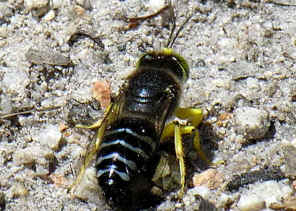
- The guarding wasp The guarding wasp at rest.
- About ten minutes later the provisioning wasp came back (we checked the photos carefully by comparing the body pattern, we are sure it is the same wasp.) Both wasp flied together in small circuit over the nest with loud buzzing sound, with frequency change, could be a form of communication. Then the guarding wasp guided the provisioning wasp to the nest entrance, the provisioning wasp dig into the nest as before.
- The two wasp look a bit different. The guarding wasp had the black thorax while the provisioning wasp had yellow markings on it. We saw at least once the guarding wasp chased away another sand wasp. With about an hour of observation, we saw only two wasp related with this nest.


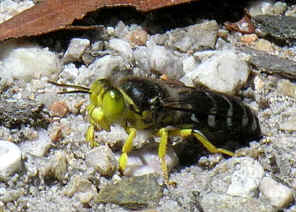
- The provisioning wasp at the entrance, digging by front legs.. The guarding wasp
- Notice the front legs of the sand wasps, which shaped like a shovel, good for digging. We carefully check the photos, the provisioning wasp came back with a small insect carried by its mouth. We can only see some small legs and cannot tell what is the small insects. From the reference information the sand wasp feed their young with flies.
- From watching those wasps, including the Mud-Dauber Wasp. Because their habit of building nest and get food for their young, they are vulnerable for cuckoo type of parasite. Wasps had evolved different ways to solve this problem. Sharing the nest entrance and guarding the nest is one of the effective way to avoid parasite. This also paving the path for the evolution to Social wasp.
Building nest alone ? Or not ..................
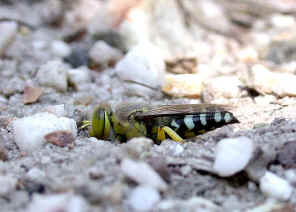
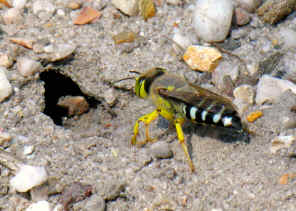

- Opening the nest entrance.



- However, by carefully inspecting the photos, we found one photo (above) with the wasp hovering outside but still has some sand coming out from the nest. This imply another wasp was working inside !!



- Also found this wasp in the reserved are near Tingalpa Reservoir on Nov 2009.
- Reference:
- 1. Bembix species (sand wasp) - ECOWATCH, Entomology, CSIRO.
- 2. Insects of Australia and New Zealand - R. J. Tillyard, Angus & Robertson, Ltd, Sydney, 1926, p299.
- 3. The Sand Wasps: Natural History and Behavior - By Howard Ensign Evans, Kevin M. O'Neill, Harvard University Press, 2007, Fig 7.7.
A week later we went to the nest site again. We did find one working in the
site. It was alone, came out from the nest a few times, get in again minutes
later, always with empty hand. Then it get in the nest and did not came out
for over an hours. We saw some sand came out from the nest entry so it should
be building the cell inside. We waited over an hours and gave up.
